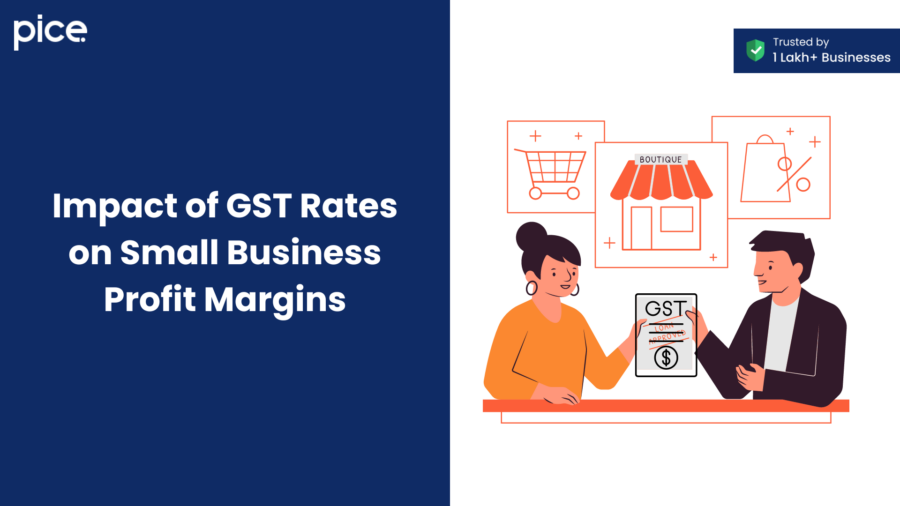Impact of GST on Small and Medium Enterprises (SMEs) in India
- 24 Sep 24
- 10 mins

Impact of GST on Small and Medium Enterprises (SMEs) in India
Key Takeaways
- GST simplifies the Indian tax system by combining multiple indirect taxes into one, promoting ease of compliance for businesses.
- Small businesses benefit from GST with easier registration, simplified taxation, and reduced logistics costs.
- GST eliminates the cascading effect of taxes, allowing businesses to claim input tax credits and avoid double taxation.
- While GST boosts tax transparency, SMEs face challenges like complex invoice management and cash flow constraints.
- Large firms may have a competitive edge under GST, while small businesses can struggle with price fluctuations and compliance issues.
The Goods and Services Tax is one of the most significant indirect tax reforms enacted by the Indian Parliament. The implementation of GST made a significant mark in India's indirect taxation system, with a far-reaching impact on all business sizes.
GST had both positive and negative impacts on Small and Medium Enterprises, which are referred to as the backbone of the Indian Economy. GSTN aimed to create a unified tax structure with less compliance burden.
In this blog, we will discuss the impact of GST on small businesses, the purpose of GST implementation and its positive and negative impact on business performance.
Purpose of GST Implementation
Some of the primary objectives of GST implementation in India are:
- Single Unified Market
Goods and Services Tax subsumes several indirect taxes under one head. This not only eliminated the non-parity of Central and State taxes but also ensured the seamless flow of goods from one state to another without additional taxes. This also led to the creation of a single unified market, the promotion of fair competition and reduced high business compliance costs.
- Simplification of Taxation System
Combining many indirect taxes into one reduces the administrative burden on government and businesses. The framework of GST is supported by digital services which makes tax filing, refunds and many such processes done easily through the online portal. Additionally, this saves time and reduces the risk of human error.
- Elimination of the Cascading Effect of Double Taxation
Before the implementation of GST, consumers bore the tax burden of multiple indirect taxes. GST introduced an Input Tax Credit which allows businesses to claim credits on the taxes they pay on input services. This eliminates the cascading effect by ensuring tax is charged only on value-addition of each supply chain's stage.
- Reducing Tax Evasion
The taxation system of Goods and Services Tax is more transparent. Every transaction is recorded which makes it difficult to evade taxes. Businesses are required to report all their purchases and sales to claim Input Tax Credit. This ensures that they maintain accurate records and refrain from using any unfair means.
- Broadening of Tax Base
With a lower GST registration threshold, more businesses are included under the current tax regime. This not only boosts tax revenues but also distributes the tax burden more widely. A broader tax base helps formalise the economy and improve tax compliance.
Positive Effects of GST on SMEs
SMEs contribute almost half of the industrial output in India, and 42% of total export. The positive effects of Goods and Services Tax on SMEs are:
- Easier Launching of a New Business
Before the implementation of GST, business operations were required to register for Value Added Tax with the sales tax department of each state where they wanted to run business activities. Rules were different for each state which made the process difficult for compliance. Since it is a centralised registration under GST, the rules remain the same for all states in India.
💡If you want to pay your GST with Credit Card, then download Pice Business Payment App. Pice is the one stop app for all paying all your business expenses.
- Simplification of the Taxation Process
The primary objective of GST implementation is the elimination of the cascading effect of tax-on-tax. It aims to decrease the complications of the different central and state taxes. Since under GST, there is a uniform tax rate on goods and services, indirect taxes will be combined into one single tax.
- Decreased Logistics Costs
The previous tax regime led to transportation issues with long checkpoint queues, raising labour and fuel costs. GST solves this with IGST for interstate sales, combining CGST and SGST, and collected by the Central Government. This eliminates checkpoints and border taxes, reducing logistics costs.
- Removal of Distinction Between Goods and Services
Previously, businesses were required to calculate service tax and VAT individually. GST simplifies the process by eliminating the distinction between goods and services. Now tax is calculated on the final total rather than on individual products or services. Additionally, this will also be advantageous for SMEs as they will be eligible for a tax incentive on the procurement of input goods and services.
- Higher Threshold Limits for New Businesses
Under the previous tax regime, businesses with an annual turnover between ₹5 lakh and ₹10 lakh (varied by state) were required to register and pay taxes. With GST, taxpayers can avoid tedious formalities and pay GST only if their turnover exceeds a specified limit. The GST exemption limit is set at ₹40 lakhs for goods and ₹20 lakhs for services, so businesses with annual revenues below these thresholds are not required to register.
Challenges Faced in Implementation of GST
Here are some of the significant challenges SMEs face with GST implementation:
- Invoice Management Issues
Under GST, it is essential to preserve all invoices with accurate details. Additionally, the generation of the invoice should be based on certain strict rules. This can pose a challenge for a small business, especially since they often have limited time and resources.
- Limited Understanding
Understanding and implementing the new GST regulations can be difficult for some small and medium-sized enterprises. Moreover, there are chances of different interpretations of the law by different owners which can create confusion among entrepreneurs.
- Complications in Filing
It is important to be up to date with the tax returns filing. Failure to file GST returns within the deadlines can lead to hefty penalties and will negatively impact your compliance rating on GST's GSTN portal. Small businesses that do not have access to a lot of resources may find it difficult to comply.
- Cash Flow Difficulties
Businesses need to pay GST on the purchase of goods or services upfront. They receive the input tax credit only after the goods are sold. This means that unsold products can block the working capital and cause cash flow challenges.
- Influence of GST on Small Business Pricing Strategies
The laws of GST impact the pricing of small businesses. GST increases market competition, making small business owners hesitant to raise their prices.
Impact of GST Rates on Small Business Profit Margins

Let us discuss the positive and negative effects of GST rates on small business profit margins:
Positive Impact
Here are some of the positive impacts of GST rates on the profit margins of small businesses:
- Easier Tax Compliance: Under the previous tax system, businessmen had to include multiple taxes in their prices, making tax obligations confusing. GST is easy to understand which not only saves business costs but also results in better pricing.
- Clear Pricing: Previously, it was required to maintain two prices, for goods and services. This made the tax structure confusing. GST combines two into one. This makes the pricing structure clear, making it easier for consumers and businesses to follow.
- Easier Transportation of Goods: Before GST, moving goods between states meant multiple checks and stops, which slowed down deliveries and raised costs. With GST, transportation is more efficient and cheaper, allowing businesses to offer their products at better prices.
Negative Impact
The following are the negative impacts of GST rates on the profit margins of small businesses. Take a look:
- Advantageous for Big Firms: Big companies that have access to more resources will find it easier to adapt to GST regulations. This can make them charge competitive market prices, making it difficult for small businesses to match up to the level.
- Complicated Pricing Bundles: GST can make the pricing of a bundled service complicated. It is challenging for business owners to set prices which are both profitable for businesses and fair to consumers.
- Price Fluctuations: As businesses are continually learning the new GST regulations, they are likely to keep changing prices to figure out the best one. With the price change, confusions arise among consumers regarding spending and purchase.
The Bottom Line
The impact of GST on small businesses is multi-faceted. The positive impacts were easier compliance, input tax credits and seamless transportation of goods. Having said that, the need for technological support and adapting to new regulations within limited areas has caused difficulties.
 By
By 

















